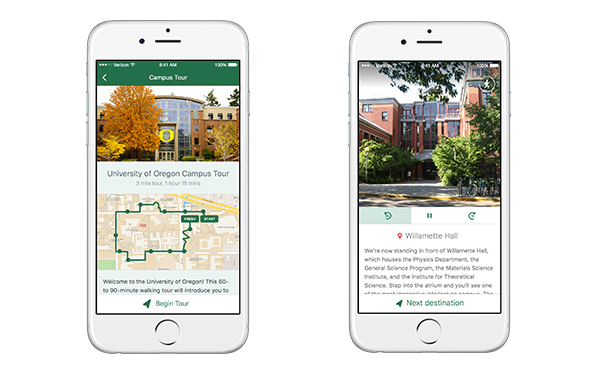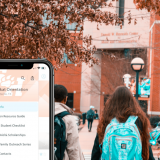University of Oregon looks to creatively meet rising admissions goals as resources decrease
How a mobile strategy is helping the university increase applications and conversions
University admissions offices are constantly looking to increase campus visits and applications. Given that 85% of college students own a smartphone and students spend 8-10 hours a day on these devices, a mobile strategy is increasingly necessary for colleges to win students over.
By partnering with Guidebook to develop a mobile guide for admissions, featuring a self-guided audio tour of campus, the university will be able to reach thousands of students who might otherwise have committed to a school without being able to see all that Oregon has to offer.
University of Oregon began using Guidebook’s technology to offer students a guide for orientation in 2014, replacing paper agendas and to-do lists. Because mobile turned out to be such a success for Welcome Week, Cora Bennett, the Director of Orientation Programs at University of Oregon, decided to develop the mobile campus tour guide. Now with a self-guided tour, the admissions office can get prospective students to download their app before they are even admitted. It is a great way to increase exposure and keep millennials engaged in university communications.
“To know that we were working with a company that we knew and trusted, it took about 5 seconds to say yes… it wasn’t a hard choice for us,” said Bennett.
Since launching in January, the Oregon Tour app has received 800 unique downloads. Bennett has received positive feedback from users, including colleagues who have referred people to the tour, or taken it themselves to learn more about their campus – evidence that a tour app benefits not only prospects, but current students and staff as well. Bennett and her team have big plans for the app down the road and are continuing to set new goals in order to keep up with department goals.
The challenge: rising admissions goals
Each year the metrics and key performance indicators (KPIs) that admissions staff must reach are rising. Despite this, the available headcount and resources of staff members are decreasing as budgets tighten.
Bennett has felt this pressure year over year. Her department is measured on several key metrics in order to maintain an increasing pool of applicants, including yield out of visits (the number of students who apply after visiting) and deposit yield (the number of students who make their deposit after a campus visit).
“Currently, we are noticing about a 65% yield from admits to deposits after an on-campus tour. We want to get that number to 75% by next year. That is a big goal.”
With this in mind, University of Oregon started brainstorming ways to shake things up.
Getting creative and finding quick wins
Prior to making overarching changes to their programs, University of Oregon decided to look for simple, innovative ways to increase the number of students touring each year. An obvious place to start was with students who visit unannounced or through a non-traditional tour. While an ambassador-led tour is the best possible way to advertise your campus, 75% of high school seniors say they’ve toured a campus on their own without the aid of a guide.
“We see a lot of students who come to campus for football games, basketball games, or are part of a model UN team. They think they know the U of O because they have come to campus for some other reason, but they have never really experienced one our of admissions sessions, open house events, or the tour.” – Cora Bennett
Instead of letting these prospective students go unnoticed, Oregon used Guidebook to build a self-guided audio tour for visitors. On the tour, students are guided through all of the points of interest on campus using their phone’s GPS, and each stop on the tour is narrated by a recording of a real Oregon student ambassador. Immediately after completing the tour a clear request for information prompts students to contact admissions, creating an opportunity for future dialogue. Throughout their deliberation process, a student can easily refer back to the University of Oregon app, which has plenty of relevant information that can help with that all-important decision.
Data-driven success
Capturing the students who previously came to campus and were completely untracked will help increase these admissions KPIs. An additional benefit of the app is providing data that can surface ways to increase the effectiveness of current programs. In the current competitive landscape, it’s imperative for admissions offices to think strategically about how to improve their tour experience, and ultimately decrease the margin of students who tour a school and then chose not to attend.
To begin capturing this data, University of Oregon trained their ambassadors to prompt all prospective students, even those who attend a guided tour, to download their app. With no extra effort, the admissions team is able to track where a student is dropping off on the self-guided tour. Using this data, Bennett and her team can quickly learn and adapt their tour. For example, if they find that many students who take the self-guided tour close the app at a certain point of interest on campus, they can rearrange the tour stops or consider removing that location. In the same vein, they can capture valuable information on how often students are opening their app and reviewing their content. Since February, University of Oregon’s tour app has been opened an average of four times per user. This shows that students are revisiting the app several times and referring back to it for information throughout the spring semester.
Understanding these metrics allows Oregon to benchmark themselves against their goals and strive for continual improvement of their programs. Bennett and her team are ready to make smart decisions based on this data, and are certain this will give them a boost in their initiatives.
“We are cutting staff and budget in order to shift priorities on our campus or because states are funding campuses less. Campuses are having to be a lot more creative about how to deliver things in general.”
After they wrap up the school year, Cora has time set aside to strategically evaluate the program and determine ways she can improve it. Until then, her entire staff has implemented an incredible promotion plan from website advertisements to “wet” graffiti on campus that is visible every time it rains. While the program is still in its infancy, there has already been positive feedback.
“It was really a perfect piece of the puzzle to develop an ongoing virtual relationship with a student and still allow them to feel a bit anonymous.”
While University of Oregon has invested several resources into getting this program up and running, it is a small price to pay in the long run of their always rising admissions goals. Bennett and her team will continue to innovate and adapt the way they develop relationships with students, especially as circumstances in the market are rapidly evolving.



